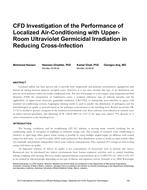Localized airflow has been proven able to provide both temperature and pollutant concentration segregations with limited air mixing between adjacent occupied zones. However, it is not clear whether this type of air distribution can prevent cross-infection within the locally conditioned zone. The aim of this paper is to investigate using computational fluid dynamics (CFD) the transmission of Staphylococcus aureus, a common infectious type of airborne bacteria, and the applicability of upper-room ultraviolet germicidal irradiation (UR-UVGI) in minimizing cross-infection in spaces with localized air-conditioning systems. Lagrangian tracking model is used to predict the distribution of pathogens, and the microbiological air quality is assessed based on the pathogen concentration at the breathing level. Results reveal that UR-UVGI is needed to protect occupants in the localized environmental zone from airborne cross-infection in extreme cases of indoor bacteria generation, that delivering 54 W (184.25 BTU/h) UVC to the space may achieve 70% decrease in S. aureus concentration at the breathing level.
Citation: International Conference on Efficient Building Design, Materials and HVAC Equipment Technologies; October 2-3, 2014; Beirut, Lebanon
Product Details
- Published:
- 2014
- Number of Pages:
- 8
- File Size:
- 1 file , 2.5 MB
- Product Code(s):
- D-ICEB14-23
